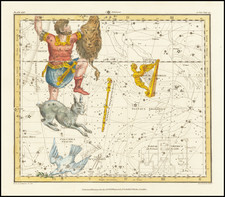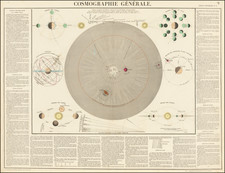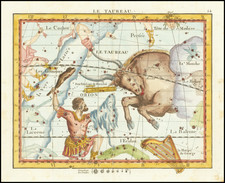Interesting circular diagram centered around the Biblical verse "Fiat lux et facta est lux" from the Cosmographia, delineating the divine creation of luminaries to segregate day from night. Crafted during the era of burgeoning scientific inquiry, this artifact embodies the confluence of theological doctrine and astronomic observation.
The Cosmographia, a pivotal text from the European Renaissance, amalgamated scientific knowledge with religious interpretation, mirroring a period when humanity’s understanding of the cosmos was in profound transformation. The illustration serves as a testament to the era’s inclination towards harmonizing scripture with the empirical study of the heavens, a pursuit that laid the groundwork for modern astronomy.
The diagram, rendered in a restrained yet precise monochrome, exhibits the heavens partitioned by the celestial markers of the time— a visual representation as much an educational tool as a theological statement. The Latin inscriptions, rooted in scripture, reinforce the period’s belief in a universe governed by a divine architect, offering insight into the era's didactic methods.
The specific verses referenced are as follows:
-
Genesis 1:14: "Dixit autem Deus: 'Fiant luminaria in firmamento cæli ut dividant diem ac noctem et sint in signa et tempora et dies et annos'" Translation: "And God said, 'Let there be lights in the firmament of the heaven to divide the day from the night; and let them be for signs, and for seasons, and for days, and years'"
-
Genesis 1:15: "et luceant in firmamento cæli et illuminent terram et factum est ita" Translation: "And let them be for lights in the firmament of the heaven to give light upon the earth: and it was so."
-
Genesis 1:16: "Fecitque Deus duo luminaria magna luminare majus ut præesset diei et luminare minus ut præesset nocti" Translation: "And God made two great lights; the greater light to rule the day, and the lesser light to rule the night"
-
Genesis 1:17-18: "et posuit eas in firmamento cæli ut lucerent super terram et præessent diei ac nocti et dividerent lucem ac tenebras" Translation: "He set them in the firmament of the heaven to give light upon the earth, And to rule over the day and over the night, and to divide the light from the darkness."
These texts are significant as they depict the Biblical account of creation, where the celestial bodies are ordained to not only illuminate the earth but also to define and regulate the passage of time. The diagram itself reflects a historical viewpoint where the cosmos was understood through a lens of religious doctrine, with the movements of celestial bodies interpreted as part of a divine order. This perspective was common during a time when astronomical studies were often conducted by clerics and scholars who sought to reconcile their observations with their faith.












![[Hydra]](https://storage.googleapis.com/raremaps/img/small/67628.jpg)
![Globi Coelestis In Tabulas Planas Redacti Pars I. . . [ Ursa Major, Camelopardius, Lynx S. Tigris, Cassiopea, Cepheus, Draco, and Ursa Minor ]](https://storage.googleapis.com/raremaps/img/small/71118.jpg)
![[ Corona Meridionalis ]](https://storage.googleapis.com/raremaps/img/small/83175.jpg)